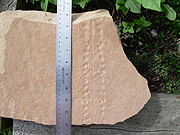
Protichnites
Encyclopedia

Trace fossil
Trace fossils, also called ichnofossils , are geological records of biological activity. Trace fossils may be impressions made on the substrate by an organism: for example, burrows, borings , urolites , footprints and feeding marks, and root cavities...
consisting of the imprints made by the walking activity of arthropod
Arthropod
An arthropod is an invertebrate animal having an exoskeleton , a segmented body, and jointed appendages. Arthropods are members of the phylum Arthropoda , and include the insects, arachnids, crustaceans, and others...
s. It is likely that more than one type of arthropod was responsible for these tracks. Euthycarcinoid
Euthycarcinoid
Euthycarcinoida is a group of amphibious freshwater arthropods that until recently were only known from the Carboniferous onwards. A single Ordovician/Silurian individual was identified in the Tumblagooda sandstone in 1993; a Devonian example was added from the Rhynie chert in 2003, and most...
s, aglaspidids (see Aglaspida
Aglaspida
The Aglaspida, more correctly termed Aglaspidida, were a group of small, horseshoe crab-like arthropods that were once regarded as basal or ancestral horseshoe crabs. However they cannot be accommodated within the chelicerates. Now, though, they are regarded as a distinct group, possibly being...
) and eurypterid
Eurypterid
Eurypterids are an extinct group of arthropods related to arachnids which include the largest known arthropods that ever lived. They are members of the extinct order Eurypterida ; which is the most diverse Paleozoic chelicerate order in terms of species...
s are possible contributors. Protichnites consists of two rows of tracks and a linear depression between the two rows. This depression, which may be broken, set at an angle, and of varying width and depth, is thought to be the result of a dragging tail. The structures bearing this name were typically made on the tidal flats of Paleozoic
Paleozoic
The Paleozoic era is the earliest of three geologic eras of the Phanerozoic eon, spanning from roughly...
seas, but similar ones extend into the Cenozoic
Cenozoic
The Cenozoic era is the current and most recent of the three Phanerozoic geological eras and covers the period from 65.5 mya to the present. The era began in the wake of the Cretaceous–Tertiary extinction event at the end of the Cretaceous that saw the demise of the last non-avian dinosaurs and...
. Its occurrence in late Cambrian
Cambrian
The Cambrian is the first geological period of the Paleozoic Era, lasting from Mya ; it is succeeded by the Ordovician. Its subdivisions, and indeed its base, are somewhat in flux. The period was established by Adam Sedgwick, who named it after Cambria, the Latin name for Wales, where Britain's...
sandstones of Canada and northern United States is evidence of some of the first life on land.

